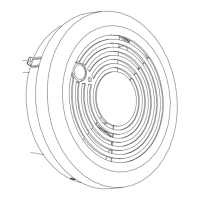SINGLE-STATION PHOTOELECTRIC
SMOKE DETECTOR
SD-738/w USER’S MANUAL
TABLE OF CONTENTS
INTRODUCTION................................................................... 1
page 1 (SD738-EI00 04/2004)
LOCATIONS TO INSTALL YOUR SMOKE DETECTOR ..... 1
LOCATIONS NOT TO INSTALL YOUR SMOKE
DETECTORS ........................................................................ 2
INSTALLING YOUR SMOKE DETECTOR ........................... 2
TESTING YOUR SMOKE DETECTOR ................................ 3
TAKING CARE OF YOUR SMOKE DETECTOR ................. 3
TIPS TO ENHANCE YOUR PROTECTION FROM FIRES .. 3
MORE TIPS TO FACE A FIRE IN YOUR HOME ................. 3
SPECIFICATIONS ................................................................ 4
SMOKE DETECTOR WITH OPTIONAL WIRELESS
TRANSMITTER INFORMATION .......................................... 4
FIVE YEAR LIMITED WARRANTY....................................... 4
INTRODUCTION
Everday’s single station photoelectric smoke detector is designed to sense
smoke that comes into the detector chamber. It does not sense gas, heat, or
flame. This smoke detector is designed to give early warning of developing
fires by giving off the alarm sounds from its built-in alarm horn. It can provide
precious time for you and your family to escape before a fire spreads.
However, the smoke detector makes such pre-warning of fire accident
possible, only if the detector is located, installed, and maintained properly as
described in this User's Manual.
WARNING:
This smoke detector is designed for use in a single residential
unit only, which means that it should be used inside a single-family home or
apartment. It is not meant to be used in lobbies, hallways, basements, or
another apartment in multi-family buildings, unless there are already working
detectors in each family unit. Smoke detectors, placed in common areas
outside of the individual living unit, such as on porches or in hallways, may not
provide early warning to residents. In multi-family buildings, each family living
unit should set up its own detectors.
WARNING:
This detector is not meant to be used in non-residential
buildings. Warehouses, industrial or commercial buildings, and special
purpose non-residential buildings require special fire detection and alarm
systems. This detector alone is not a suitable substitute for complete fire
detection systems for places where many people live or work, such as hotels
or motels. The same is true of dormitories, hospitals, nursing homes or group
homes of any kind, even if they were once single-family homes. Please refer
NFPA 101, the Life Safety Code, NFPA71, 72A, 72B, 72C, 72D, and 72E for
smoke detector requirements for fire protection in buildings not defined as
“households”.
WARNING:
This detector will not alert people who are hard of hearing. It is
strongly recommended that the special-purpose smoke detectors, using lights
or vibrating devices, should be installed to alert occupants who are hard of
hearing.
LOCATIONS TO INSTALL YOUR SMOKE DETECTOR
Smoke detectors should be installed in accordance with the NFPA Standard
74 (National Fire Protection Association, Batterymarch Park, Quincy, MA
02169). For complete coverage in residential units, smoke detectors should
be installed in all rooms, halls, storage areas, basements, and attics in each
family living unit. Minimum coverage is one detector on each floor and one in
each sleeping area. Here, we have good tips for you:
• Install a smoke detector in the hallway outside every separate bedroom
area, as shown in Figure 1. Two detectors are required in homes with
two bedroom areas, as shown in Figure 2.
• Install a smoke detector on every floor of a multi-floor home or apartment,
as shown in Figure 3.
• Install a minimum of two detectors in any household.
• Install a smoke detector inside every bedroom.
• Install smoke detectors at both ends of a bedroom hallway if the hallway
is more than 40 feet (12 meters) long.
• Install a smoke detector inside every room where one sleeps with the
door partly or completely closed, since smoke could be blocked by the
closed door and a hallway alarm may not wake up the sleeper if the door
is closed.
Figure 1: LOCATIONS FOR PLACING
SMOKE DETECTORS FOR
SINGLE RESIDENCE WITH
ONLY ONE SLEEPING AREA
Figure 2: LOCATIONS FOR PLACING SMOKE DETECTORS FOR
SINGLE-FLOOR RESIDENCE WITH MORE THAN ONE SLEEPING
AREA
Figure 3: LOCATION FOR PLACING
SMOKE DETECTORS FOR A
MULTI-FLOOR RESIDENCE
• Install basement detectors at the bottom of the basement stairwell.
• Install second-floor detectors at the top of the first-to-second floor
stairwell.
• Be sure no door or other obstruction blocks the path of smoke to the
detector.
• Install additional detectors in your living room, dining room, family room,
attic, utility and storage rooms.
• Install smoke detectors as close to the center of the ceiling as possible. If
this is not practical, put the detector on the ceiling, no closer than 4
inches (10 cm) from any wall or corner, as shown in Figure 4.
• If ceiling mounting is not possible and wall mounting is permitted by your
local and state codes, put wall-mounted detectors between 4 and 6
inches (10 ~ 15 cm) from the ceiling, also see Figure 4.
Figure 4:
RECOMMEN
DED BEST
AND
ACCEPTABLE
LOCATIONS
TO MOUNT
SMOKE
DETECTORS
• If some of your rooms have sloped, peaked, or gabled ceilings, try to
mount detectors 3 feet (0.9 meter) measured horizontally from the
highest point of the ceiling as shown in Figure 5.

